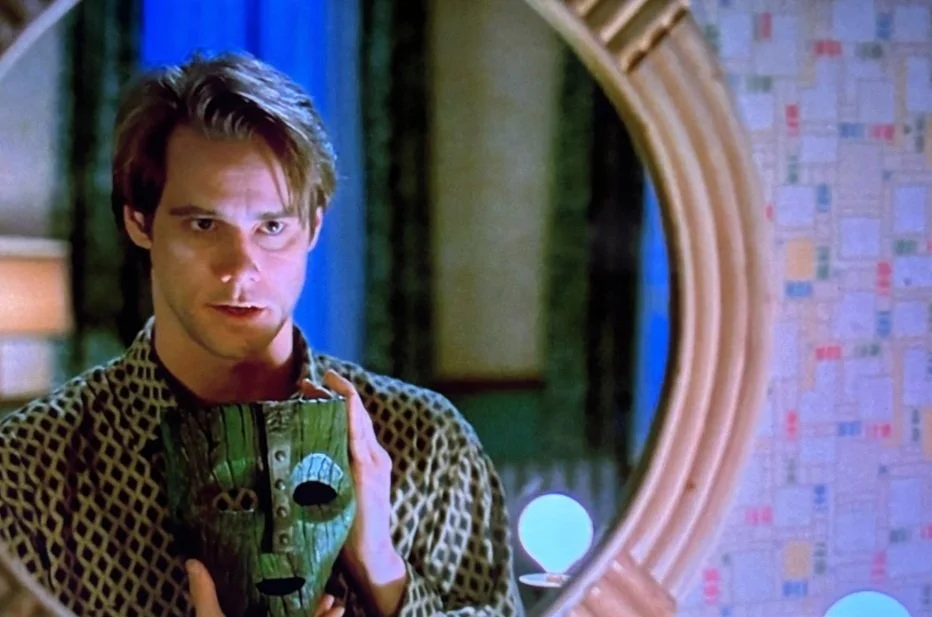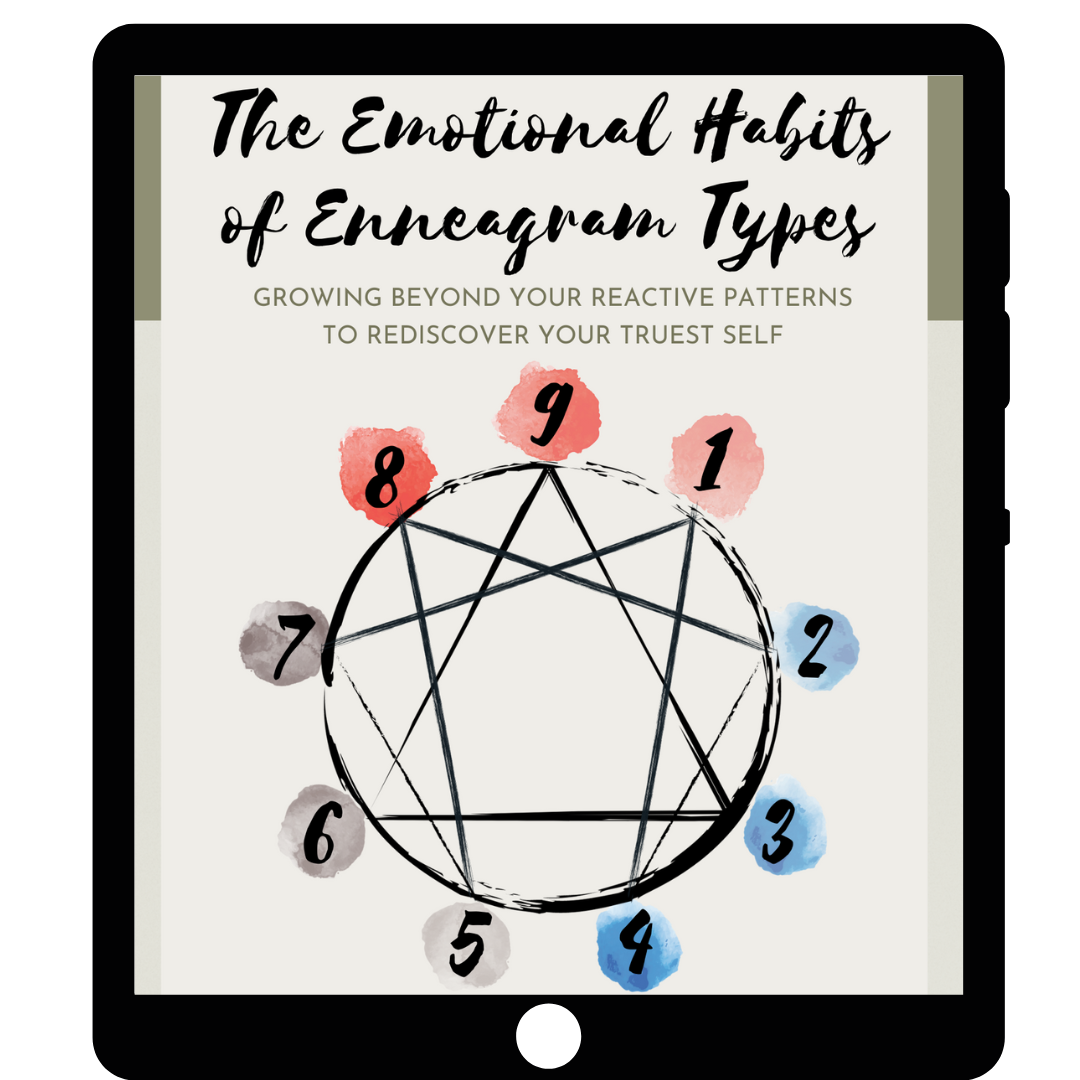Seeing the Enneagram Archetypes on Screen
Stories help us see important truths in life, especially when it’s about sensitive or tricky topics like our own personality and defense mechanisms.
There are a number of movies I love using to explain what the Enneagram is, how it works, and why it matters for our own healing & growth.
This blog will be exploring how the Jim Carrey classic “The Mask” (1994) is a phenomenal illustration about how:
we all wear masks (the outward-facing aspects of ourselves) to deal with life
forget who we truly are along the way, and
need to find our way back to our true selves.
The Mask and the Enneagram: What Jim Carrey's Classic Teaches Us About Personality
In this zany movie that has no shortage of exaggerations, we see Jim Carrey’s character, Stanley Ipkiss, the quintessential Enneagram 9 who is the perfect example of how our True Self (AKA our essence) tries to navigate through life’s experiences, but falls asleep to himself by putting on a whole other Enneagram 3-like persona (literally meaning, “the mask”) when he finds it too painful to show up as his real self.
The rest of the movie illustrates what happens when our rejected, repressed inner parts take over — useful in the beginning, but disastrous in the long run.
By the way, all the nine Enneagram types are archetypes of the universal human experience. Even if you yourself are neither Type 9 or Type 3, since Type 9 represents the aspect of all of us who falls asleep to our true selves, and Type 3 represents all the ways we live according to how we think we SHOULD be in the world, you can still find your own story reflected here. Just swap out the details of what your themes and patterns are.
Before the Mask: Our True Selves (Essence)
Jim Carrey’s character, Stanley Ipkiss, is the ultimate “nice guy.” He’s sweet, accommodating, and deeply uncomfortable with asserting himself.
He avoids rocking the boat and risking conflict or tension, tries to keep everyone (else) happy, and dreams of a more exciting life—but rarely takes action for himself. Instead, he resigns himself to just taking things as they come — being overly content or seeking comfort or complacency.
“Remember? Nice guys finish last.”
Stanley downplays himself both in front of obstacles (avoiding conflict) and opportunities (not asserting himself) in ways it makes the audience cringe on his behalf.
(AGHH! If only you would JUST. FREAKIN. SAY. SOMETHING!!)
(If you felt this frustration watching these scenes, this is probably you taking on what Stanley disowned and outsourced. He underly advocates for himself, and unintentionally summons someone else (i.e., YOU) to overly take on that responsibility and get upset on his behalf. This is how projection works. Neat, huh? I digress.)
Stanley reflects how Enneagram 9s (AKA The Peacemaker, Harmonizer) generally operate.
In their sloth slumber of falling asleep to their true selves, Type nines:
Avoid conflict at all costs
Have trouble asserting their needs or opinions or just putting themselves out there
Often feel overlooked, unimportant, or ignored (yet feel squeamish about doing or saying anything about it)
Escape into fantasy, comfort, or routines to avoid discomfort (narcotization is their primary psychological defense mechanism)
Repress anger until it bubbles over through passive aggression, builds up until it explodes, or disappears entirely (supposedly)
Stanley doesn’t speak up at work, gets walked all over, consistently misses his shot to connect, and struggles to be known on a deeper level.
But inside? There's a storm of unexpressed feelings, desires, and longings just waiting to erupt.
How do these repressed parts show up? Immediately after his junk of a rental car (top) breaks down on the bridge and he smashes his hand (rage outburst) or in his dreams (bottom):
How he lives sees himself and is seen: drab, broken, unwanted, boring, loser
What his repressed longings want: to be successful, suave, powerful, charismatic
The Mask: A Symbol of Repressed or Disowned Parts of Ourselves
After an infuriating incident with the car, Stanley comes across this magical mask, which unbeknownst to him we later find to be a creation of Loki — the God of Mischief — notorious for his shapeshifting abilities.
When Stanley returns home, he tosses the mask aside and switches the TV channel to an interview of a psychiatrist author of the book “The Masks We Wear”, where he says:
“We all wear masks, metaphorically speaking.”
“We suppress the id, our darkest desires…”
“…and adopt a more socially acceptable image.”
In other words, these masks help us portray ourselves differently on the outside to be accepted by others and to succeed in life.
Putting on the Mask: Taking on a New Persona
Sick and tired of being a life-long loser, Stanley puts on the magical mask, and his world turns upside down (what he thinks is rightside up).
“It’s like it brings your innermost desires to life.”
What are Stanley’s innermost desires? To be a powerful, uninhibited, unfiltered, yet wildly charismatic being, who can alter himself and his surroundings into whatever is wanted or needed in each moment.
“Somebody stop me!”
As the Mask, Stanley says what he wants, takes what he wants, and doesn’t care what anyone thinks. He becomes the exaggerated, uninhibited version of himself — in the same way that Enneagram 3s are the complete “opposite” of Enneagram 9s.
This is exactly what the Enneagram is about.
It’s like our true face is too sensitive to the outside world — it’s too intense, too scary, too much. So we put on a mask to help us get by.
Everyone has a “mask”— a false identity, a coping strategy developed to protect the self from fear, shame, or vulnerability.
Every Enneagram type is a specific mask — a specific false identity that comes with their respective coping strategies and defense mechanisms. These are what’s going on behind-the-scenes for each type:
The Masks of the Nine Enneagram Types
Enneagram Ones (the Improver): “How can I be perfect?”
Themes: good/bad, right/wrong, all/nothing
Protect from the risk of uncertainty & feeling out of control
Enneagram Twos (the Befriender): “How can I be lovable?”
Themes: intimacy, connection, closeness
Protect from the risk of being rejected for who they truly are
Enneagram Threes (the Performer): “How can I be seen as successful?”
Themes: success, admiration, productivity, spotlight
Protect from the risk of truly being a “loser”
Enneagram Fours (the Individualist): “How can I be memorable?”
Themes: uniqueness, distinction, difference
Protect from the risk of being ordinary (thus abandoned)
Enneagram Fives (the Observer): “How can I be knowledgable?”
Themes: knowledge, expertise, competency
Protect from the risk of being overwhelmed or not self-sufficient
Enneagram Sixes (the Loyalist): “How can I be safe?”
Themes: safety/danger, security, trust/mistrust
Protect from risk, period.
Enneagram Sevens (the Enthusiast): “How can I be free?”
Themes: experience, sensationalism, opportunity, and play
Protect from the risk of being trapped, especially in pain
Enneagram Eights (the Challenger): “How can I be invulnerable?”
Themes: power, will, and change
Protect from the risk of being vulnerable or influenced by others
Enneagram Nines (the Harmonizer): “How can I be invulnerable?”
Themes: peace, unity, oneness, comfort
Protect from the risk of being a Self/agent of change
When Things Go Sideways: Fusing with Our Mask
If only these masks really gave us what we truly want!
It’s not like The Mask is turning Stanley into someone else. It’s revealing parts of Stanley that were already there — always there — just deeply buried, out of his conscious awareness because it was too painful to lead life with those parts.
The Masked Version isn’t true integration (a reconciliation of various parts). Instead, it’s overcompensation. Instead of internal harmony, Stanley is still split and polarized on the inside, making him reactive (exaggerated) on the outside.
When we wear these masks long enough, our face fuses with the mask to the point where we forget that the mask is not our actual face. We only value ourselves for part of who we are because we don’t remember that there’s a whole lot more to us than what we (and others) can see.
Though these defense mechanisms and coping strategies WERE useful when we were ACTUALLY vulnerable and without many resources, there comes a point where they start CAUSING problems.
“But it’s wrecking my life.”
These masks were appropriate backup options to have when we really didn’t have alternative ways of taking care of ourselves.
But what happens when we technically OUTGROW our need for defense mechanisms but we/our masks don’t quite get the memo?
All our coping skills know how to do is to cope — to problem solve according to what they THINK is the problem.
And if there’s no problem, it summons one from thin air. Namely, it CREATES problems that it knows how to solve, because what else is it supposed to do?
Stanley felt like he was on top of the world, the object of everyone’s desires, accomplishing things he never dreamed of doing with such ease…
…until he realized that most of the admiration and affection he was receiving was for this persona that he’s so split off from. But none of these are truly “him” — rather, they’re distorted expressions of hidden desires, shadow traits, and unmet needs.
Namely, he’s only known and valued for only PART of himself, not ALL of himself.
Even when his love interest Tina (Cameron Diaz) really is drawn to the non-masked self, Stanley can’t quite tell that she loves him, since he continues to reject and minimize himself.
At some point in his story, Stanley realizes that his mask is GETTING IN THE WAY for him to get what he really wants — to be known and connected and to have a place in this world for who he really is.
The pain far outweighs the gain, so he’s ready to finally confront the real issue: integrating the internal split parts. In order for him to truly be fulfilled, he needs to take the risk and do the scary thing: take off the mask, reveal his true self, and own what’s rightfully his instead of repressing them.
“When he [The Mask] is gone, all that’s left is me [my true self].”
Taking Off Our Mask: Integrating with Our Shadows and Repressed Parts
The issue isn’t that we have masks on. It’s that we’ve fused to our masks that we’ve forgotten who we really are underneath it.
Our Enneagram types and the identities and coping strategies aren’t bad — it’s just that they were designed with the specific purpose of taking care of us when we were actually vulnerable.
Growth and healing work doesn’t involve getting rid of the mask, but recognizing that:
There are more masks than just our type — 8 whole other ones!
None of these masks are supposed to replace who we really are
These masks come in handy — as long as we can wisely discern what each situation calls for so we can put on (and take off) these masks on command, without ever forgetting ourselves.
The goal isn’t to reject or throw away undesirable aspects of ourselves to grasp for what we perceive to be the exact opposite. That just swings us to the opposite extreme, which isn’t sustainable either.
The goal isn't to swing wildly from repression to explosion, or from invisibility to domination.
The goal is to INTEGRATE — to gather the various parts and dimensions of ourselves and to make it whole.
It’s not that Stanley was a Type 9 who then became a Type 3. He always has been MORE THAN both Type 9 and Type 3:
When he was in 9-ness (pre-Mask) of self-effacing placation, his 3-ish patterns of self-assertive dynamism were already there — just buried.
When he was in 3-ness (with the Mask) of dynamic self-promotion, his 9-ish patterns didn’t disappear — it still hung out out beneath the surface.
When he took off the Mask (and kept it off), it wasn’t like he just reverted back into being 9-ish. Instead, by the end, Stanley embodies steady confidence — a harmonizing blend of 9-ish and 3-ish traits that looks qualitatively different than either type.
By the end, we see Stanley knowing and trusting his true self, his true power, and his true place in the world. He says what he needs to say, but doesn’t need to exaggerate or conceal. He takes up his rightful space because he knows he’s important without having to be all-important.
The power, admiration, and magnetism he was looking for outside himself through the Mask turns out to have been within himself this entire time: he just needed to embody it to see it for himself.
After Stanley takes off the Mask, all that’s left is him…and that’s all he needs to be.
WARNING — When You Refuse Your True Self and Choose the Mask
The villain Dorian Tyrell is an example of what happens when we DON’T integrate power and think that the mask is GOOD and our true self is BAD.
In Tyrell’s case, the Mask completely took over, and he overidentified with his coping strategies and disconnected from his authentic self.
(In this case, I would guess he’s either a very unhealthy Enneagram 8 or Type 4SX, but any other type could just as easily become the villain.)
Just because Tyrell’s mask is taken away from him in the end doesn’t mean he’s actually free of its influence — if the opportunity presented himself, he would likely opt to put back on (and keep on) this powerful alter ego.
He hasn’t (yet) had the change of heart, which only comes AFTER one realizes that what the Mask offers is just a shallow counterfeit of what one actually needs (like intimacy).
Tina used to be in a relationship with Tyrell but was turned off by his insecurities — it wasn’t that she rejected him per se but his sensitive/kind side was so deeply engulfed by this invulnerable exterior that there was no way for her to make it through and no one for her to actually connect with.
Had Tyrell connected with and led with his inner tenderness, he wouldn’t have objectified and repelled Tina. The very things he wanted — power, recognition, and/or connection — are stripped away from him, not by external factors, but by his own choosing the Mask over his true self.
You are MORE than Your Enneagram Type/Mask
It’s usually in the wake of mask-induced problems (i.e., existential crises) that people have that change of heart/rock bottom experience and reach out for therapy. People’s go-to patterns just don’t work the way they used to, and yet they don’t know what else to do.
It’s in the process of taking a deep, hard look at the parts of us that we often ignore (our shadows and other repressed needs) and actually integrating them back into ourselves that we (re)emerge as our truest selves (our essence).
A lot of people think that their Enneagram type/mask is ALL of who they are. Some even celebrate and reinforce that. However, it’s likely that the louder our Type’s patterns, the more fused and trapped we are to our own masks. We think we’re free, even though we’re actually enslaved.
When we’ve really done our inner work, our types/masks lose their effect — even though we have the capacity to make decisions in these familiar ways, we’re not defined to them.
It’s a common sign that when someone has really done a lot of internal work, it’s harder to discern what Enneagram type they are.
When we reconcile aspects of ourselves BEYOND our Enneagram type, we become more whole, grounded, resilient, free, and fulfilled.
If you find yourself being frustrated or exhausted from trying to figure out life, the issue might NOT be that you don’t know how to fix this problem.
The true issue might be that what you THOUGHT was the solution is actually CREATING problems to begin with.
Which Mask Do You Have? Ready to Release It?
The Enneagram isn’t just about recognizing our type — it’s about noticing the mask we wear to survive, and asking:
“Is this really me? Or is this just who I THINK I need to be to feel safe, loved, or powerful?”
Of the nine Enneagram types, which ones sound most like how you engage life? How is that mask working out for you?
If you don’t know your type, check out this blog!
If you’re sick and tired of your autopilot patterns and are wanting to grow BEYOND your type, here are two options:
What are your Enneagram type's emotional habits?
Grab this free guide that shows you how to grow beyond the patterns that keep you stuck!
Don't know your Enneagram type?
Find yours here!
© Copyright 2023 Joanne B. Kim. All rights reserved.
JOANNE B. KIM, LMFT
Joanne is a Licensed Marriage & Family Therapist and Certified Brainspotting Practitioner in San Jose, CA. She helps people EXHAUSTED by anxiety, shame, and an allergic reaction to anger create VIBRANT relationships where they matter, too.
Many of her clients are:
(1) the highly responsible, conscientious, and empathic types
(2) Enneagram Type Ones, Twos, Fours, or Nines
(3) Highly Sensitive Persons (HSPs)
The most common words spoken by those who’ve sat with Joanne:
“I thought it was just me. I’m NOT crazy!”
“I can finally figure out what to do with all these feelings!”
















































See how the Enneagram and genogram reveal trauma, boundaries, and generational patterns in families like the Bridgertons — and maybe yours too!